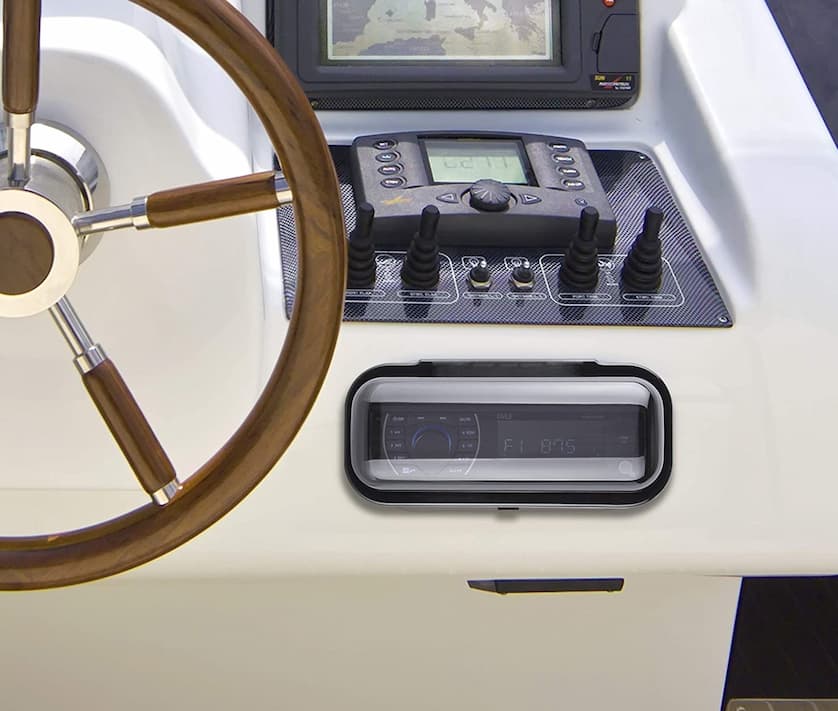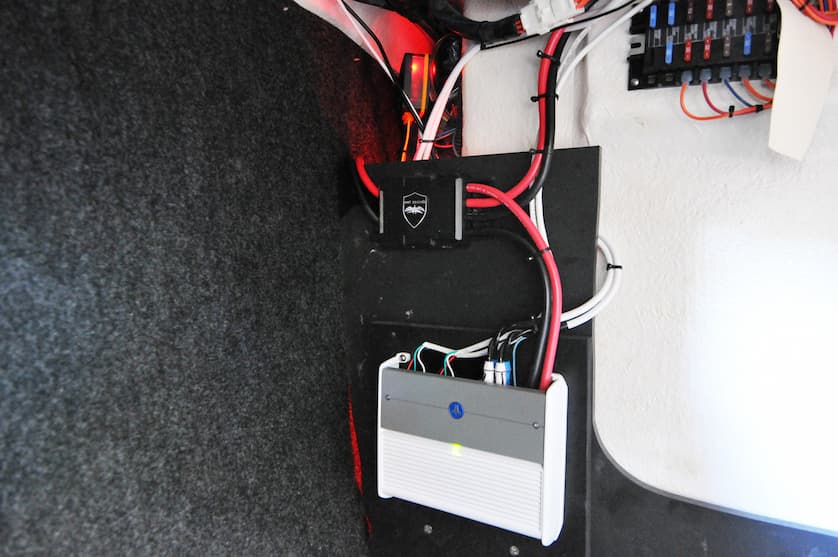Marine stereos are more than just your regular car radio. As their name states, these stereos are specifically designed to withstand many of the harsh conditions that can occur while being on a boat – from the open climate to the extreme temperatures in the middle of the sea.
So, whether you’re the main captain organizing cruise tours to Alaska, or you’re just casually riding your little boat for fun, here’s what you need to consider when choosing a marine stereo.
Contents
Marine Stereo Features

As we mentioned, marine stereos are designed to withstand all the harsh conditions that come with boating adventures. But except for that, these stereos can also feature a couple of conveniences to make the entire experience more amusing. Let’s see what features are we talking about
Water and UV Resistance
You probably know that your car stereo isn’t resistant to many elements, and can easily get destroyed if it gets in touch with splashes of water and light rain. For this purpose, marine stereos feature different levels of water-resistance as well as coated circuit boards, plated connections and rust-resistant chassis components to prevent rusting and corroding.
On the other hand, being exposed to the direct sun isn’t something that can’t occur while being on a boat trip. Hence, a good marine radio will also feature UV resistance, especially on compounds such as receiver faceplates, speaker cones and remote controls.
Specs
It’s generally known that marine radios feature better specs than your typical car radio. Hence, these radios should always be able to offer a high CD signal-to-noise ratio, a lot of RMS power and a wide frequency response.
Bluetooth Connection
As the technology nowadays goes far beyond the basic AM/FM radios, make sure you choose from the huge range of Bluetooth marine stereos for your boat. Having Bluetooth connectivity will let two different devices automatically scan and detect each other, which gives you a wide range of new opportunities. In other words, Bluetooth marine stereos will allow you to connect them to one or multiple smartphones and adjust some features such as power, volume and song control.
However, the technology behind your Bluetooth marine stereo goes way beyond switching songs and controlling the volume. This connectivity also allows you to make calls while you’re offshore. This way, you don’t even have to take your hand off the helm, which is very convenient when it comes to riding a boat.
Wireless vs Wired Remotes
Your marine stereo will require a compatible remote, and there’re two types of them- wired and wireless ones. Wired remotes can be mounted in any convenient location you’re visiting more frequently. For instance, you can have your marine stereo mounted in your cabin while having a couple of wired remotes at the helm, at the swim platform etc.
On the other hand, wireless models usually feature the RF( radio frequency) technology, meaning you don’t even have to point your remote to the stereo to control it, as they work through walls and any other obstacles. Except for RF, wireless remotes can also feature IR (infrared) technology- the same one used for TV remotes. However, have in mind that IR doesn’t work well when exposed to direct sunlight.
Power Output

Unless you’re planning to use an external amplifier, the power output of the marine stereo is one of the most important factors you should consider
Hence, when it comes to power outputs, the first thing you need to do is to determine the peak power- the amount of power your unit can produce at any given instant. On the other hand, RMS or continuous power is the average amount of power that the unit can put out over time. And since the RMS power is always lower than the peak power, it makes for a more important factor than the peak power generally.
When it comes to many of the marine stereo’s peak power, most of them will put out 40 to 60 watts per channel. And since these stereos typically have 4 channels, the total peak power output will range from 160 to 240 watts, which translates to 15 to 25 watts of RMS continuous power per channel.
However, keep in mind that being on a boat means being out in the open. This means that there is nothing to bounce the sound waves off or to bring them back, which implies the need for a high-power stereo to produce a clean and clear sound.
On the other hand, stereo units featuring more than 240 watts of peak power are very hard to find, and this is why it’s recommended to use an external amplifier. Not only will an amplifier give you excellent sound quality and a lot of volume, but they’re also very handy when you need the power to connect more than 4 speakers.
Installation Size

Last, but not least, the size of the stereo unit can be one of the deciding factors, especially if you’re replacing your old stereo with a new one. This is due to your old stereo leaving a cutout hole you should fill with your new one. On the other hand, it’s not uncommon to struggle to find mounting and adapter plates, as they’re not readily available. All of these factors point to purchasing a marine stereo that will fit the existing hole as the best option
The standard stereo body size in the past was typically around 7″x 2″ (177mm x 50mm), which is not the case with nowadays’ marine stereos. However, it won’t be as hard to find a stereo featuring a standard-sized chassis with a larger faceplate that overlaps the installation surface, so make sure you consider this when making your choice.
On the other hand, many modern marine stereos are designed for streaming music from sources such as iPods, smartphones and different MP3 players. And since CD players are no more required, many of the modern stereo units are round and have a shallow mounting depth, and look more like a mounted remote than the traditional stereo system. So make sure you take all of these factors into consideration, so you don’t invest in something that you won’t even use. Now that you know the basic aspects of marine stereos, it’s time to hit the market and upgrade your boat with a new one.










